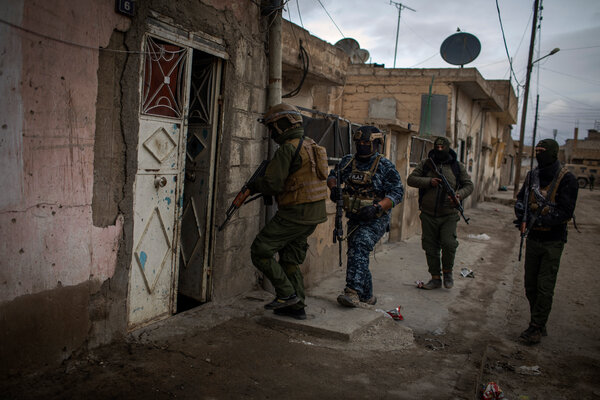The U.S.-backed Syrian Democratic Forces militia demanded that about 60 ISIS militants, still holed up in a prison a week after they attacked it, give themselves up or risk being killed.
HASAKA, Syria — A U.S.-backed militia in Syria delivered a surrender-or-die ultimatum on Friday to dozens of Islamic State fighters holding out in a prison a week after they attacked it, saying they would face an all-out military assault if they did not give themselves up.
The Islamic State assaulted the Sinaa prison in the city of Hasaka in an attempt to free thousands of former ISIS fighters, breaching the walls with bombs and holding some of the almost 700 child detainees there as human shields, according to the militia, the Syrian Democratic Forces, or the S.D.F. The clashes drew in American forces to back the Kurdish-led S.D.F.
On Wednesday, the S.D.F. declared that it had regained full control of the entire prison complex after six days of fighting. But on Thursday, battles raged on to expel the fighters still holed up in the prison.
Siyamend Ali, media director of the People’s Protection Units, the main Syrian-Kurdish paramilitary group within the S.D.F., offered an explanation on Friday for the confusion. He said the militia discovered on Thursday that about 60 ISIS fighters had been hiding undetected in a basement in one of the buildings in the makeshift prison complex.
“We gave them a time limit: If they don’t surrender, then we will use military methods,” said Mr. Ali, speaking near the site of the prison as U.S. armored fighting vehicles from a nearby base sped past, American flags waving. He said they would be killed if they did not surrender.
Mr. Ali would not say what the deadline was for the surrender ultimatum. He did say that the S.D.F. was sending messages to the fighters by loudspeaker, but that the fighters had not responded.
The Aftermath of Syria’s Civil War
After a decade of fighting, many Syrians wonder if the country can be put back together.
- The ISIS Fight Isn’t Over: Attacks in Syria and Iraq make it clear that the Islamic State is re-emerging as a serious threat.
- A Landmark Trial: A German court convicted a former Syrian officer of crimes against humanity in a historic verdict for those seeking justice.
- The Toll of U.S. Airstrikes: Secret American forces repeatedly killed Syrian civilians and bombed a vitial dam on a “no-strike” list.
- Bashar al-Assad’s Tenuous Grip: Despite his apparent victory in the civil war, the Syrian president remains mired in crises.
- A Drug Empire Flourishes: Powerful associates of Mr. al-Assad are making and selling amphetamines, turning Syria into a new narcostate.
He said the remaining militants were believed to have been among those who attacked the prison rather than detainees, and that they were armed with assault rifles and machine guns, some of them seized from prison guards killed in the assault.
Shortly after Mr. Ali spoke, fighters from the People’s Protection Units brought someone out from near the prison complex and detained him. They identified the person as an ISIS foreign fighter from Saudi Arabia and said they found him hiding in a house behind the prison.
New York Times correspondents saw the suspect, a man with white hair and a graying beard and wearing a track suit, carrying a black-and-silver briefcase with multiple envelopes, one of them containing Saudi currency. The S.D.F. said other envelopes contained dollars and a Saudi passport.
The man said he had the money because he had been in Saudi Arabia for a pilgrimage.
As journalists watched, S.D.F. fighters shoved him into a vehicle and drove away. One of the fighters held him in a headlock.
The U.S.-led coalition has conducted airstrikes and sent in a small number of ground troops to help the S.D.F. take back the prison in the biggest battle between American forces and ISIS since the fall of the last piece of the group’s so-called caliphate in 2019.
The makeshift prison held about 3,000 suspected ISIS fighters and almost 700 boys.
An S.D.F. spokesman said Wednesday that at least 30 militia fighters and more than 100 militants had been killed. The final tally is expected to be considerably higher.
On Thursday, the S.D.F. traded fire from the rooftops with dozens of Islamic State fighters and fired rocket-propelled grenades at the partly destroyed prison complex.
Fighting on Thursday also raged in areas surrounding the prison complex. In a neighborhood nearby, hundreds of Kurdish special forces fanned out, going house to house to search for escaped prisoners and ISIS fighters in hiding. The neighborhood was mostly empty.
The United Nations children’s agency, UNICEF, said the fighting had forced 45,000 people in this city of one million to flee their homes, most of them women and children. Some have gone to stay with relatives while others ended up in shelters in the city.
The fate of the 700 boys was still not completely clear. The boys, aged 10 to 18, have been held for three years in the prison because their parents had joined the Islamic State. Some may have been recruited by ISIS as child fighters.
The S.D.F. has said that the boys had been in a separate building but got mixed up with the adult prisoners during the siege, and that some were given arms and “pushed into clashes.” The boys who have been recaptured or surrendered have been resegregated from the adult prisoners.
Mr. Ali said on Thursday that he was not aware that any of the child hostages had been killed in the fighting but that information about what happened to all of the prisoners was still being assessed.
He said that more than 3,000 detainees had surrendered and that most had been taken to a new detention facility built by the U.S.-led coalition that has fought the Islamic State in Syria.


























